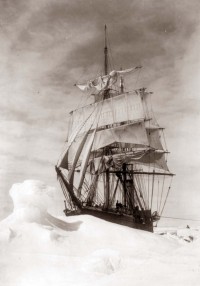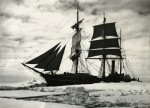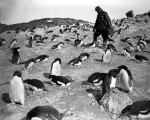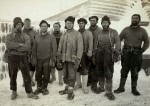 The SS Terra Nova began life in 1884 as a whaler and seal hunting vessel on the Labrador Sea between Canada and Greenland. After a starring role carrying Captain Robert Falcon Scott and his team to the other end of the earth, it returned to duty in its home waters. There, damaged by ice, it went down on September 13th, 1943, off the southwestern coast of Greenland.
The SS Terra Nova began life in 1884 as a whaler and seal hunting vessel on the Labrador Sea between Canada and Greenland. After a starring role carrying Captain Robert Falcon Scott and his team to the other end of the earth, it returned to duty in its home waters. There, damaged by ice, it went down on September 13th, 1943, off the southwestern coast of Greenland.
 On July 11 of this year, the Schmidt Ocean Institute was testing new echosounders, devices that use sound pulses to map the depth of water, in preparation for their use on a 2013 research mission when they found not just how deep the coastal waters on the southern tip of Greenland are, but the wreck of the Terra Nova. It wasn’t a freakish coincidence. One of the reasons they chose the location was that it had been reported as the site of the sinking, so if they did find the wreck it would be a useful calibration tool.
On July 11 of this year, the Schmidt Ocean Institute was testing new echosounders, devices that use sound pulses to map the depth of water, in preparation for their use on a 2013 research mission when they found not just how deep the coastal waters on the southern tip of Greenland are, but the wreck of the Terra Nova. It wasn’t a freakish coincidence. One of the reasons they chose the location was that it had been reported as the site of the sinking, so if they did find the wreck it would be a useful calibration tool.
On the first line of the calibration survey, on-board survey expert Jonathan Beaudoin from the University of New Hampshire had noted a feature on the seabed which remained initially unidentified. Upon completion of the main calibration exercise, SOI technician Leighton Rolley and Jonathan reviewed each of the many potential targets identified during the 12 hours of surveying, and the target was noted as a strong candidate for further investigation. Multibeam data expert Jean Marie from Ifremer analyzed the feature in more detail, finding its length (57m) to match the reported length of the Terra Nova.
Encouraged by the similarity in length, the acoustic survey team post-processed the collected multi-beam data to verify the observed feature. A shorter survey from several angles reaffirmed the possibility that the team had found a wreck.
 The research team then sent down a weighted high resolution camera package that they built to film plankton net tows. The camera recorded a wooden shipwreck with its funnel lying next to it. They compared the footage of the funnel to historical pictures of the Terra Nova and it was a match.
The research team then sent down a weighted high resolution camera package that they built to film plankton net tows. The camera recorded a wooden shipwreck with its funnel lying next to it. They compared the footage of the funnel to historical pictures of the Terra Nova and it was a match.
The Schmidt Ocean Institute reported the find to the U.S. State Department, which notified the British and Danish governments. All parties agreed to allow the information to be released as long as the specific location or identifying details were kept quiet to keep the site from interference by souvenir hunters wanting a piece of such a legendary vessel.
 The Terra Nova’s legendary status began when it departed Bute Docks, Cardiff on June 15th, 1910 to explore Antarctica and reach the South Pole. Although there was a general exploratory purpose, Captain Scott’s main aim was to plant the Union Jack on the South Pole. He was already a popular hero since his return from the Discovery Expedition of Antarctica in 1904. With the added boost of pre-World War I jingoism and a year spent traveling the country giving lectures and raising funds for the new expedition, by the time the Terra Nova took off, national excitement was at a peak.
The Terra Nova’s legendary status began when it departed Bute Docks, Cardiff on June 15th, 1910 to explore Antarctica and reach the South Pole. Although there was a general exploratory purpose, Captain Scott’s main aim was to plant the Union Jack on the South Pole. He was already a popular hero since his return from the Discovery Expedition of Antarctica in 1904. With the added boost of pre-World War I jingoism and a year spent traveling the country giving lectures and raising funds for the new expedition, by the time the Terra Nova took off, national excitement was at a peak.
 Scott had had the ship’s hull reinforced with seven feet of oak, but it still got stuck in pack ice between New Zealand and the Antarctic for 20 days. That delay, bad weather and other problems kept the team from making camp where they had first planned. They laid their main supply depot (where the butter was recently found) a full 35 miles north of the intended location, a fatal error, as it turned out.
Scott had had the ship’s hull reinforced with seven feet of oak, but it still got stuck in pack ice between New Zealand and the Antarctic for 20 days. That delay, bad weather and other problems kept the team from making camp where they had first planned. They laid their main supply depot (where the butter was recently found) a full 35 miles north of the intended location, a fatal error, as it turned out.
 After collecting an exceptional amount of data about the flora and fauna, all documented in photographs and on film by Herbert Ponting, on November 1st, 1911, Scott took a caravan of people and supplies south towards the Pole. Most of them turned back. Only five men including Scott reached the South Pole on January 17th, 1912, only to find the Norwegian flag planted by Roald Amundsen who had reached the Pole on December 14th, 1911.
After collecting an exceptional amount of data about the flora and fauna, all documented in photographs and on film by Herbert Ponting, on November 1st, 1911, Scott took a caravan of people and supplies south towards the Pole. Most of them turned back. Only five men including Scott reached the South Pole on January 17th, 1912, only to find the Norwegian flag planted by Roald Amundsen who had reached the Pole on December 14th, 1911.
 Beaten by barely more than a month, a dejected Scott and his team set out on the return voyage of 800 miles. By the time they reached the halfway mark, they had already lost one man. Another would die on March 16th, leaving just three men to make camp on March 19th just 11 miles from the main supply camp, 24 miles past the original location they had intended for it. There they were hit with a blizzard that kept them from moving. Frostbitten, out of supplies, the men died one after the other, with Scott being the last to die. His last journal entry was on the 29th of March.
Beaten by barely more than a month, a dejected Scott and his team set out on the return voyage of 800 miles. By the time they reached the halfway mark, they had already lost one man. Another would die on March 16th, leaving just three men to make camp on March 19th just 11 miles from the main supply camp, 24 miles past the original location they had intended for it. There they were hit with a blizzard that kept them from moving. Frostbitten, out of supplies, the men died one after the other, with Scott being the last to die. His last journal entry was on the 29th of March.
Their bodies would not be discovered until the next summer, in November 1912. The Terra Nova left for home in January 1913. Purchased by its former owners, it went right back to work in the seal hunting grounds of Newfoundland. Meanwhile Scott’s death, so heartbreakingly captured in his journals, made him a national hero.
In 1924, Herbert Ponting made a documentary of the doomed voyage using the footage he’d taken and some recreations of events he hadn’t captured on film. The Great White Silence has been remastered and is now available on DVD and Blu-Ray.
Here’s the Terra Nova in happier times, departing from Cardiff with crowds to see the valiant explorers off:
[youtube=http://www.youtube.com/watch?v=RR8aNabrWL8&w=430]
Here’s the Terra Nova today:
[youtube=http://www.youtube.com/watch?v=Bar1jMJv_Rw&w=430]